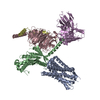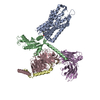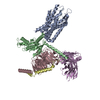+ Open data
Open data
- Basic information
Basic information
| Entry | Database: PDB / ID: 8fn1 | ||||||
|---|---|---|---|---|---|---|---|
| Title | CryoEM structure of Go-coupled NTSR1 | ||||||
 Components Components |
| ||||||
 Keywords Keywords |  MEMBRANE PROTEIN / MEMBRANE PROTEIN /  GPCR / GPCR /  neurotensin receptor / allosterism / SBI-553 neurotensin receptor / allosterism / SBI-553 | ||||||
| Function / homology |  Function and homology information Function and homology informationresponse to antipsychotic drug / Peptide ligand-binding receptors /  neuropeptide receptor binding / G protein-coupled neurotensin receptor activity / inositol phosphate catabolic process / positive regulation of inhibitory postsynaptic potential / symmetric synapse / response to mineralocorticoid / D-aspartate import across plasma membrane / positive regulation of gamma-aminobutyric acid secretion ...response to antipsychotic drug / Peptide ligand-binding receptors / neuropeptide receptor binding / G protein-coupled neurotensin receptor activity / inositol phosphate catabolic process / positive regulation of inhibitory postsynaptic potential / symmetric synapse / response to mineralocorticoid / D-aspartate import across plasma membrane / positive regulation of gamma-aminobutyric acid secretion ...response to antipsychotic drug / Peptide ligand-binding receptors /  neuropeptide receptor binding / G protein-coupled neurotensin receptor activity / inositol phosphate catabolic process / positive regulation of inhibitory postsynaptic potential / symmetric synapse / response to mineralocorticoid / D-aspartate import across plasma membrane / positive regulation of gamma-aminobutyric acid secretion / L-glutamate import across plasma membrane / mu-type opioid receptor binding / positive regulation of arachidonic acid secretion / neuron spine / neuropeptide receptor binding / G protein-coupled neurotensin receptor activity / inositol phosphate catabolic process / positive regulation of inhibitory postsynaptic potential / symmetric synapse / response to mineralocorticoid / D-aspartate import across plasma membrane / positive regulation of gamma-aminobutyric acid secretion / L-glutamate import across plasma membrane / mu-type opioid receptor binding / positive regulation of arachidonic acid secretion / neuron spine /  corticotropin-releasing hormone receptor 1 binding / regulation of respiratory gaseous exchange / neuropeptide hormone activity / digestive tract development / negative regulation of systemic arterial blood pressure / hyperosmotic response / negative regulation of release of sequestered calcium ion into cytosol / G alpha (q) signalling events / positive regulation of glutamate secretion / positive regulation of inositol phosphate biosynthetic process / corticotropin-releasing hormone receptor 1 binding / regulation of respiratory gaseous exchange / neuropeptide hormone activity / digestive tract development / negative regulation of systemic arterial blood pressure / hyperosmotic response / negative regulation of release of sequestered calcium ion into cytosol / G alpha (q) signalling events / positive regulation of glutamate secretion / positive regulation of inositol phosphate biosynthetic process /  temperature homeostasis / dopamine receptor signaling pathway / response to corticosterone / response to lipid / temperature homeostasis / dopamine receptor signaling pathway / response to corticosterone / response to lipid /  regulation of membrane depolarization / cellular response to lithium ion / detection of temperature stimulus involved in sensory perception of pain / neuropeptide signaling pathway / response to axon injury / G protein-coupled serotonin receptor binding / axon terminus / regulation of membrane depolarization / cellular response to lithium ion / detection of temperature stimulus involved in sensory perception of pain / neuropeptide signaling pathway / response to axon injury / G protein-coupled serotonin receptor binding / axon terminus /  transport vesicle / response to amphetamine / blood vessel diameter maintenance / cellular response to dexamethasone stimulus / adult locomotory behavior / cellular response to nerve growth factor stimulus / positive regulation of release of sequestered calcium ion into cytosol / dendritic shaft / response to cocaine / liver development / transport vesicle / response to amphetamine / blood vessel diameter maintenance / cellular response to dexamethasone stimulus / adult locomotory behavior / cellular response to nerve growth factor stimulus / positive regulation of release of sequestered calcium ion into cytosol / dendritic shaft / response to cocaine / liver development /  muscle contraction / muscle contraction /  learning / G-protein beta/gamma-subunit complex binding / Olfactory Signaling Pathway / Activation of the phototransduction cascade / learning / G-protein beta/gamma-subunit complex binding / Olfactory Signaling Pathway / Activation of the phototransduction cascade /  visual learning / G beta:gamma signalling through PLC beta / Presynaptic function of Kainate receptors / Thromboxane signalling through TP receptor / adenylate cyclase-modulating G protein-coupled receptor signaling pathway / G-protein activation / G protein-coupled acetylcholine receptor signaling pathway / Activation of G protein gated Potassium channels / Inhibition of voltage gated Ca2+ channels via Gbeta/gamma subunits / Prostacyclin signalling through prostacyclin receptor / Glucagon signaling in metabolic regulation / G beta:gamma signalling through CDC42 / visual learning / G beta:gamma signalling through PLC beta / Presynaptic function of Kainate receptors / Thromboxane signalling through TP receptor / adenylate cyclase-modulating G protein-coupled receptor signaling pathway / G-protein activation / G protein-coupled acetylcholine receptor signaling pathway / Activation of G protein gated Potassium channels / Inhibition of voltage gated Ca2+ channels via Gbeta/gamma subunits / Prostacyclin signalling through prostacyclin receptor / Glucagon signaling in metabolic regulation / G beta:gamma signalling through CDC42 /  terminal bouton / cytoplasmic side of plasma membrane / ADP signalling through P2Y purinoceptor 12 / G beta:gamma signalling through BTK / Sensory perception of sweet, bitter, and umami (glutamate) taste / Synthesis, secretion, and inactivation of Glucagon-like Peptide-1 (GLP-1) / photoreceptor disc membrane / Adrenaline,noradrenaline inhibits insulin secretion / Glucagon-type ligand receptors / Vasopressin regulates renal water homeostasis via Aquaporins / G alpha (z) signalling events / cellular response to catecholamine stimulus / Glucagon-like Peptide-1 (GLP1) regulates insulin secretion / ADORA2B mediated anti-inflammatory cytokines production / adenylate cyclase-activating dopamine receptor signaling pathway / ADP signalling through P2Y purinoceptor 1 / G beta:gamma signalling through PI3Kgamma / cellular response to prostaglandin E stimulus / Cooperation of PDCL (PhLP1) and TRiC/CCT in G-protein beta folding / sensory perception of taste / GPER1 signaling / G-protein beta-subunit binding / terminal bouton / cytoplasmic side of plasma membrane / ADP signalling through P2Y purinoceptor 12 / G beta:gamma signalling through BTK / Sensory perception of sweet, bitter, and umami (glutamate) taste / Synthesis, secretion, and inactivation of Glucagon-like Peptide-1 (GLP-1) / photoreceptor disc membrane / Adrenaline,noradrenaline inhibits insulin secretion / Glucagon-type ligand receptors / Vasopressin regulates renal water homeostasis via Aquaporins / G alpha (z) signalling events / cellular response to catecholamine stimulus / Glucagon-like Peptide-1 (GLP1) regulates insulin secretion / ADORA2B mediated anti-inflammatory cytokines production / adenylate cyclase-activating dopamine receptor signaling pathway / ADP signalling through P2Y purinoceptor 1 / G beta:gamma signalling through PI3Kgamma / cellular response to prostaglandin E stimulus / Cooperation of PDCL (PhLP1) and TRiC/CCT in G-protein beta folding / sensory perception of taste / GPER1 signaling / G-protein beta-subunit binding /  heterotrimeric G-protein complex / Inactivation, recovery and regulation of the phototransduction cascade / heterotrimeric G-protein complex / Inactivation, recovery and regulation of the phototransduction cascade /  extracellular vesicle / G alpha (12/13) signalling events / signaling receptor complex adaptor activity / Thrombin signalling through proteinase activated receptors (PARs) / response to estradiol / retina development in camera-type eye / extracellular vesicle / G alpha (12/13) signalling events / signaling receptor complex adaptor activity / Thrombin signalling through proteinase activated receptors (PARs) / response to estradiol / retina development in camera-type eye /  GTPase binding / Ca2+ pathway / phospholipase C-activating G protein-coupled receptor signaling pathway / G alpha (i) signalling events / fibroblast proliferation / GTPase binding / Ca2+ pathway / phospholipase C-activating G protein-coupled receptor signaling pathway / G alpha (i) signalling events / fibroblast proliferation /  perikaryon / G alpha (s) signalling events / G alpha (q) signalling events perikaryon / G alpha (s) signalling events / G alpha (q) signalling eventsSimilarity search - Function | ||||||
| Biological species |   Rattus norvegicus (Norway rat) Rattus norvegicus (Norway rat)  Spodoptera frugiperda (fall armyworm) Spodoptera frugiperda (fall armyworm)  Homo sapiens (human) Homo sapiens (human)  Escherichia coli (E. coli) Escherichia coli (E. coli) | ||||||
| Method |  ELECTRON MICROSCOPY / ELECTRON MICROSCOPY /  single particle reconstruction / single particle reconstruction /  cryo EM / Resolution: 2.88 Å cryo EM / Resolution: 2.88 Å | ||||||
 Authors Authors | Krumm, B.E. / DiBerto, J.F. / Olsen, R.H.J. / Kang, H. / Slocum, S.T. / Zhang, S. / Strachan, R.T. / Fay, J.F. / Roth, B.L. | ||||||
| Funding support |  United States, 1items United States, 1items
| ||||||
 Citation Citation |  Journal: Biochemistry / Year: 2023 Journal: Biochemistry / Year: 2023Title: Neurotensin Receptor Allosterism Revealed in Complex with a Biased Allosteric Modulator. Authors: Brian E Krumm / Jeffrey F DiBerto / Reid H J Olsen / Hye Jin Kang / Samuel T Slocum / Shicheng Zhang / Ryan T Strachan / Xi-Ping Huang / Lauren M Slosky / Anthony B Pinkerton / Lawrence S ...Authors: Brian E Krumm / Jeffrey F DiBerto / Reid H J Olsen / Hye Jin Kang / Samuel T Slocum / Shicheng Zhang / Ryan T Strachan / Xi-Ping Huang / Lauren M Slosky / Anthony B Pinkerton / Lawrence S Barak / Marc G Caron / Terry Kenakin / Jonathan F Fay / Bryan L Roth /  Abstract: The NTSR1 neurotensin receptor (NTSR1) is a G protein-coupled receptor (GPCR) found in the brain and peripheral tissues with neurotensin (NTS) being its endogenous peptide ligand. In the brain, NTS ...The NTSR1 neurotensin receptor (NTSR1) is a G protein-coupled receptor (GPCR) found in the brain and peripheral tissues with neurotensin (NTS) being its endogenous peptide ligand. In the brain, NTS modulates dopamine neuronal activity, induces opioid-independent analgesia, and regulates food intake. Recent studies indicate that biasing NTSR1 toward β-arrestin signaling can attenuate the actions of psychostimulants and other drugs of abuse. Here, we provide the cryoEM structures of NTSR1 ternary complexes with heterotrimeric Gq and GoA with and without the brain-penetrant small-molecule SBI-553. In functional studies, we discovered that SBI-553 displays complex allosteric actions exemplified by negative allosteric modulation for G proteins that are Gα subunit selective and positive allosteric modulation and agonism for β-arrestin translocation at NTSR1. Detailed structural analysis of the allosteric binding site illuminated the structural determinants for biased allosteric modulation of SBI-553 on NTSR1. | ||||||
| History |
|
- Structure visualization
Structure visualization
| Structure viewer | Molecule:  Molmil Molmil Jmol/JSmol Jmol/JSmol |
|---|
- Downloads & links
Downloads & links
- Download
Download
| PDBx/mmCIF format |  8fn1.cif.gz 8fn1.cif.gz | 225.4 KB | Display |  PDBx/mmCIF format PDBx/mmCIF format |
|---|---|---|---|---|
| PDB format |  pdb8fn1.ent.gz pdb8fn1.ent.gz | 174.6 KB | Display |  PDB format PDB format |
| PDBx/mmJSON format |  8fn1.json.gz 8fn1.json.gz | Tree view |  PDBx/mmJSON format PDBx/mmJSON format | |
| Others |  Other downloads Other downloads |
-Validation report
| Arichive directory |  https://data.pdbj.org/pub/pdb/validation_reports/fn/8fn1 https://data.pdbj.org/pub/pdb/validation_reports/fn/8fn1 ftp://data.pdbj.org/pub/pdb/validation_reports/fn/8fn1 ftp://data.pdbj.org/pub/pdb/validation_reports/fn/8fn1 | HTTPS FTP |
|---|
-Related structure data
| Related structure data |  29303MC  8fmzC  8fn0C M: map data used to model this data C: citing same article ( |
|---|---|
| Similar structure data | Similarity search - Function & homology  F&H Search F&H Search |
- Links
Links
- Assembly
Assembly
| Deposited unit | 
|
|---|---|
| 1 |
|
- Components
Components
-Guanine nucleotide-binding protein ... , 3 types, 3 molecules BCD
| #3: Protein | Mass: 25451.166 Da / Num. of mol.: 1 Source method: isolated from a genetically manipulated source Source: (gene. exp.)   Spodoptera frugiperda (fall armyworm), (gene. exp.) Spodoptera frugiperda (fall armyworm), (gene. exp.)   Homo sapiens (human) Homo sapiens (human)Gene: GNAO1 / Production host:   Spodoptera frugiperda (fall armyworm) / References: UniProt: P09471 Spodoptera frugiperda (fall armyworm) / References: UniProt: P09471 |
|---|---|
| #4: Protein | Mass: 39418.086 Da / Num. of mol.: 1 Source method: isolated from a genetically manipulated source Source: (gene. exp.)   Homo sapiens (human) / Gene: GNB1 / Production host: Homo sapiens (human) / Gene: GNB1 / Production host:   Spodoptera frugiperda (fall armyworm) / References: UniProt: P62873 Spodoptera frugiperda (fall armyworm) / References: UniProt: P62873 |
| #5: Protein | Mass: 7861.143 Da / Num. of mol.: 1 Source method: isolated from a genetically manipulated source Source: (gene. exp.)   Homo sapiens (human) / Gene: GNG2 / Production host: Homo sapiens (human) / Gene: GNG2 / Production host:   Spodoptera frugiperda (fall armyworm) / References: UniProt: P59768 Spodoptera frugiperda (fall armyworm) / References: UniProt: P59768 |
-Protein/peptide / Protein / Antibody , 3 types, 3 molecules FAE
| #1: Protein/peptide | Mass: 819.007 Da / Num. of mol.: 1 / Source method: obtained synthetically / Source: (synth.)   Rattus norvegicus (Norway rat) / References: UniProt: P20068 Rattus norvegicus (Norway rat) / References: UniProt: P20068 |
|---|---|
| #2: Protein | Mass: 45842.098 Da / Num. of mol.: 1 Source method: isolated from a genetically manipulated source Source: (gene. exp.)   Rattus norvegicus (Norway rat) / Gene: Ntsr1, Ntsr / Production host: Rattus norvegicus (Norway rat) / Gene: Ntsr1, Ntsr / Production host:   Spodoptera frugiperda (fall armyworm) / References: UniProt: P20789 Spodoptera frugiperda (fall armyworm) / References: UniProt: P20789 |
| #6: Antibody | Mass: 28668.922 Da / Num. of mol.: 1 Source method: isolated from a genetically manipulated source Source: (gene. exp.)   Escherichia coli (E. coli) / Production host: Escherichia coli (E. coli) / Production host:   Spodoptera frugiperda (fall armyworm) Spodoptera frugiperda (fall armyworm) |
-Experimental details
-Experiment
| Experiment | Method:  ELECTRON MICROSCOPY ELECTRON MICROSCOPY |
|---|---|
| EM experiment | Aggregation state: PARTICLE / 3D reconstruction method:  single particle reconstruction single particle reconstruction |
- Sample preparation
Sample preparation
| Component | Name: Ternary complex of NTSR1 MiniGo heterotrimer with scFv16 Type: COMPLEX / Entity ID: all / Source: RECOMBINANT |
|---|---|
| Molecular weight | Value: 0.147 MDa / Experimental value: NO |
| Source (natural) | Organism:   Rattus norvegicus (Norway rat) Rattus norvegicus (Norway rat) |
| Source (recombinant) | Organism:   Spodoptera frugiperda (fall armyworm) Spodoptera frugiperda (fall armyworm) |
| Buffer solution | pH: 7.5 / Details: 20mM Hepes, 0.1M NaCl, 0.00075% LMNG, 0.00075% GDN |
| Specimen | Embedding applied: NO / Shadowing applied: NO / Staining applied : NO / Vitrification applied : NO / Vitrification applied : YES : YES |
| Specimen support | Grid material: GOLD / Grid mesh size: 300 divisions/in. / Grid type: Quantifoil |
Vitrification | Cryogen name: ETHANE-PROPANE |
- Electron microscopy imaging
Electron microscopy imaging
| Experimental equipment |  Model: Talos Arctica / Image courtesy: FEI Company |
|---|---|
| Microscopy | Model: FEI TALOS ARCTICA |
| Electron gun | Electron source : :  FIELD EMISSION GUN / Accelerating voltage: 200 kV / Illumination mode: OTHER FIELD EMISSION GUN / Accelerating voltage: 200 kV / Illumination mode: OTHER |
| Electron lens | Mode: BRIGHT FIELD Bright-field microscopy / Nominal defocus max: 3200 nm / Nominal defocus min: 100 nm Bright-field microscopy / Nominal defocus max: 3200 nm / Nominal defocus min: 100 nm |
| Image recording | Electron dose: 44 e/Å2 / Film or detector model: GATAN K3 (6k x 4k) |
- Processing
Processing
CTF correction | Type: PHASE FLIPPING AND AMPLITUDE CORRECTION | ||||||||||||||||||||||||
|---|---|---|---|---|---|---|---|---|---|---|---|---|---|---|---|---|---|---|---|---|---|---|---|---|---|
3D reconstruction | Resolution: 2.88 Å / Resolution method: FSC 0.143 CUT-OFF / Num. of particles: 560249 / Symmetry type: POINT | ||||||||||||||||||||||||
| Refine LS restraints |
|
 Movie
Movie Controller
Controller





 PDBj
PDBj























